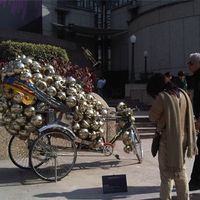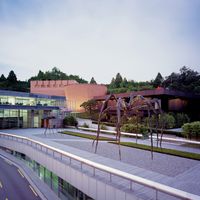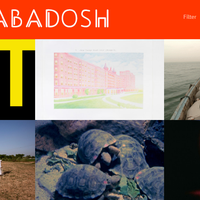Rethinking Museums | the Kiran Nadar Museum in New Delhi

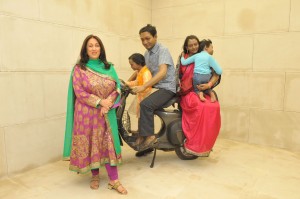 culture360.org contributor Bharti Lalwani presents the second of a series of interviews with Directors and head curators of Private museums as well as Art Advisors to discuss the phenomenon of private art museums in Asia.
culture360.org contributor Bharti Lalwani presents the second of a series of interviews with Directors and head curators of Private museums as well as Art Advisors to discuss the phenomenon of private art museums in Asia. There is a shift occuring in the art world- more and more collectors are setting up their own private art museums in order to share their massive collections with the public. This rising trend, noted especially across India, China and Southeast Asia corresponds to active patronage and private education initiatives which are reinvigorating the local art scene in countries where the lack of gallery or museum infrastructure and government funding has a direct impact on artists and their practice.
Bharti talks to Kiran Nadar, who recently launched the Kiran Nadar Museum of Art in Delhi this January which coincided with the India Art Summit, and Roobina Karode, the Chief Curator and Director of the KNMA about one of India’s premier private museums and its intended impact.
1. Roobina, as the Director and Curator of KNMA, could you please describe your role.
Roobina Karode (RK): As the Director and Curator of KNMA, my role is to envision KNMA as a landmark on the cultural landscape of the National Capital Region with its iconic building and give direction to the museum’s mission to be a ‘people-centered’ and ‘action oriented’ place. In the coming years, KNMA will be focused on growing the collection and designing programs to regularize footfalls while cultivating a museum-going culture in India.
2. With what intention was the KNMA conceived? With 300 pieces of modern and contemporary Indian art on display, tell us how the works have come to be acquired and does the museum intend to expand its collection?
Kiran Nadar (KN): I am passionate about art and hence, have been an avid collector of it. It all started with my interest in buying art and wanting to live with it. Over the years, the emphasis shifted from buying to collecting artworks and later as the collection grew, I felt unhappy with the idea that I had to put these great pieces of art into storage and not even see them myself.
As I firmly believed that art must gain appreciation for what it is, instead of being locked away, the thought of setting up my own museum arose to share the works with the general public. On January 23, 2010, the Shiv Nadar Foundation launched the Kiran Nadar Museum of Art (KNMA), India’s first philanthropic private museum. Since its inception the museum in Noida has been witnessing enormous success. KNMA began its journey as one of India’s first philanthropic museums in January 2010 with both a dream and a promise, to become not just a repository of art objects or a site for display, but act as a vital platform that initiates us into experiencing art, culture in relation to ourselves.
Merely after completing one year into this journey, KNMA launched a second museum at DLF South Court Mall, Saket, in a 18,000 sq ft space. We eventually aspire to open in a larger space, a freshly built iconic museum that will be reflective of the art it houses. The art at the KNMA has been acquired either from the artists, auctions, or purchases from galleries. And with 300 pieces of modern and contemporary art works, I believe this is just the beginning, we have a long way to travel.
3. Tell us about your developing partnerships with local and international institutions and museums?
[caption id="attachment_8652" align="alignright" width="300" caption="Bharti Kher - The Skin Speaks a Language Not Its Own, 2006"]
 [/caption]
[/caption]KN: KNMA wishes to be a place of confluence, of dialogue and communication rather than a mere repository to house the art collection. Hence the educative role of the museum is of utmost importance. Striving to provide opportunities to diverse groups, KNMA will exemplify the dynamic relationship between art and culture through its exhibitions, public and educational programs and publications. Locally, we shall be partnering with art colleges, schools and cultural institutions, artists and the art community at large. We are also working towards cross-cultural collaborations with museums in other parts of the world. We have launched KNMA with the main objective of bringing visibility to the diversifying Indian art practice – come to think of it, art is a relatively small phenomenon in a culturally and historically rich and talent laden country like India. Museum building is a much evolved phenomena outside India. There are examples that one is inspired to follow for instance, the Guggenheim Museum in New York, the Beyeler Art Museum near Basel are quite inspiring in their design. It is our endeavour to bring about the best of the modern and contemporary art at KNMA, and make it not only an example of art appreciation in India, but also showcase India’s art to the world.
4. What sort of demography are you reaching out to; what does the museum offer in order to develop its audience especially in terms of community outreach and education initiatives?
RK: Globally, modern private museums have played a large role in the blossoming of cities as iconic art hubs. Private art museums are a very recent initiative in India where the museum-going culture itself is in its infancy. We have launched the KNMA with the main objective of bringing visibility and appreciation to modern and contemporary Indian art, and present it meaningfully to the art viewing public and our growing HCL community in India and the world.
KN: It is our endeavor to bring about the best of the modern and contemporary art at the KNMA, and make it not only a platform of art appreciation in India, but also showcase India’s art to the world. We want to start a dialogue around art and cultural expression by energizing the space with well curated art exhibitions, workshops for children and for the specially-abled; global exhibitions, interface between artists and the viewing public, art appreciation workshops and educational programs which will help to bridge the gap between urban mainstream art and the people.
5. Please elaborate on KNMA’s current and future exhibitions. How do you see the KNMA evolving over the next few years?
RK: Time Unfolded, the first exhibition at the KNMA Noida was launched on January 23, 2010, which showcased art across generations that manifested artists’ perception and imagination as they addressed the time they lived in, contemplating the probable pasts and possible futures. This exhibition illustrated the interdisciplinary character of contemporary art explored through various mediums through forms of liminality and monumentality.
The current exhibition at the KNMA, DLF South Court Mall does not take a chronological route, but manifests artists’ ruminations on the multiple passages of time, as they sift through the fluid and slippery boundaries of the past and the future. Loosely grouped under sub-themes, they also tend to highlight historically marked moments in Modern and Contemporary art practice. The art collection consists of works by F.N.Souza, Rameshwar Broota, Raqib Shaw, S.H. Raza, M.F.Husain, Anish Kapoor, Subodh Gupta, Bharti Kher and Ranjini Shettar among others.
Future exhibitions would have shows curated to explore several aspects of contemporary art practice including small-format works, younger artists committed to a particular, socially engaged theme, site-specific projects, cross cultural collaborations and some more ideas that are still work-in-progress. Eventually the KNMA will be housed in an iconic, freshly built Museum in a much larger space in Delhi, which will allow it to become a place for confluence with room for interactive art appreciation discourses, workshops for children, for the lay public and the specially-abled; global exhibitions, performing arts and all the ingredients that would go into making the art hub a day-out destination of choice for all.
6. With the number of private initiatives and the lack of proactive government involvement and funding towards promoting art and culture in India, do you believe that state run museums are/ will soon be a thing of the past?
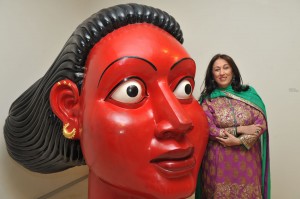 KN: Art is a relatively small phenomenon in a culturally and historically rich and talent laden country such as India. And like I said before, private art museums are a very recent initiative in India where the museum-going culture itself is in its infancy. Considering that the art culture has just embarked on a journey of awareness in India, I believe that the state run museums in India are not yet a thing of past and thus should be enhanced and maintained with regular participation by the private sector with the main objective of bringing visibility and appreciation to modern and contemporary Indian art.
KN: Art is a relatively small phenomenon in a culturally and historically rich and talent laden country such as India. And like I said before, private art museums are a very recent initiative in India where the museum-going culture itself is in its infancy. Considering that the art culture has just embarked on a journey of awareness in India, I believe that the state run museums in India are not yet a thing of past and thus should be enhanced and maintained with regular participation by the private sector with the main objective of bringing visibility and appreciation to modern and contemporary Indian art.Bharti Lalwani has a BA in Fine Art and an MA in Contemporary Art; She writes for several publications across SE Asia and India.
Similar content
18 Feb 2011
15 Feb 2011
10 Feb 2011
posted on
25 May 2016
17 Oct 2011

